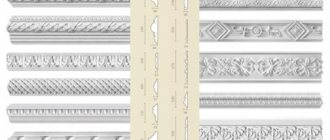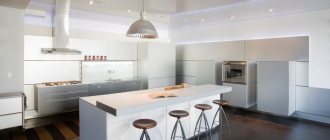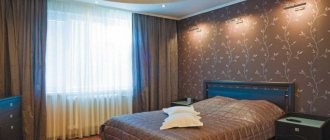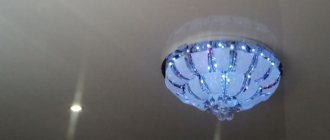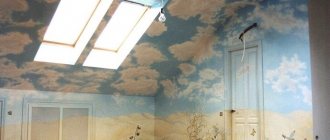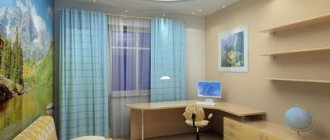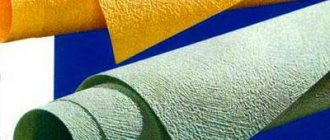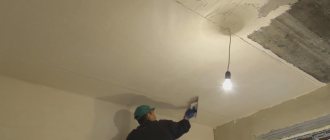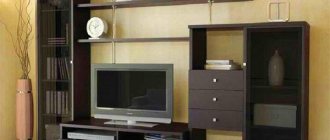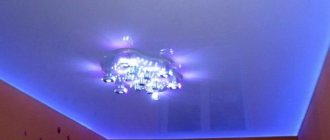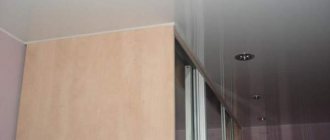The coffered ceiling is a polygonal structure with recesses, eye-catching cells and beams.
The coffered ceiling is also called lacunar, which means “recess” in Latin, and decorative, since it meets all the requirements of modern design regarding the elegance of the existing elements.
Coffered ceilings occupied their niche in the interior back in the days of ancient Greece, but then coffered ceilings had a completely different purpose.
Their use made it possible to reduce the weight of the floor slabs, and thereby eliminate unnecessary load on the beams.
To prevent the coffered surface from spoiling the overall design of the interior of the room, its protruding elements were decorated with stucco molding and drawings.
At the moment, the coffered structure is considered one of the exclusive options for the architectural design of the ceiling surface.
Its use provides a chance to transform an ordinary room into a space shining with luxury.
Photo:
The production of a coffered ceiling in the interior is based not only on compliance with a certain installation technology, but also on thinking through every detail of their designs.
The chic surface above the head is created through a variety of stencil painting and gilding, moldings, ornaments and appliqués.
Coffered ceilings in interiors
The design of the lacunar ceiling, even to an inexperienced person in the field of design, suggests with its entire appearance that it would be appropriate only in rooms with high surfaces.
Rooms with small areas, if the most original ceiling flaunts overhead, will not allow you to emphasize its exclusivity.
The coffered design, as can be seen from the photo, proves its effectiveness in rooms with a ceiling height of at least 2.5 m.
At the same time, a lacunar ceiling (including one made of polyurethane) can be installed in any space of a living room, in a living room, bedroom or study, billiard room or office.
In addition, a lacunar surface in a classic style is an excellent solution for decorating a country cottage or home, where its use will create not only an attractive design, but also impeccable acoustics.
Types of coffered ceilings and their design solutions
Caissons can make any room impressive. A similar ceiling decoration is suitable for a bedroom, living room, library, and a prestigious office. The coffering looks simply incredible in country houses with high ceilings, made in a classic style with a touch of antiquity. It is important that the initial ceiling height is at least 2.5 m, and preferably 3 m, as in old houses, otherwise the effect will be lost.
In order to somehow orient you in choosing a coffered ceiling, we will consider what materials the ceilings can be reproduced from and several design solutions.
- Classic made of wood. This is the best option for this kind of ceilings. They can be manufactured by specialized workshops or organizations that work with solid wood and produce wooden doors, stairs, and railings. Be prepared to be told the high cost of the products.
- Wood combined with MDF. This combination can reduce the cost of construction and, if executed skillfully, will be indistinguishable from a classical-style ceiling.
- Drywall and moldings. The most budget option for a ceiling, but the design is much more complicated than even a wooden one. In this case, you cannot do without a designer or architect. With a skillful approach, the use of polyurethane moldings can work wonders. Some examples can be seen in the video below
We already know what a traditional wooden coffered ceiling looks like, and now we’ll look at the possibilities of implementing a wide variety of design solutions.
- Clear edges. This style is based on the absolute geometry of the ceiling and proper differentiation of elements. A combination of light tones and rich dark ones will look very impressive, as we see in this photo
- The general center of the composition. Based on the specific layout of the room and its furnishings, you can make an accent on the ceiling in the form of a circle. It will highlight the atmosphere. Ideally, this element will be emphasized by some round object on the floor, for example a dining table, above which you can place a large crystal chandelier.
- A la Chalet. Coffered ceilings are appropriate in country houses in a rural style. You can experiment with rough, unfinished beams. The rougher they are, the more spectacular the ceiling will be. The ceiling itself can be painted in light colors or, on the contrary, very dark, so that the contrast with the wood is noticeable. In the overall interior, it is a good idea to support the ceiling structure with wooden furniture to match the beams and textiles made from natural fabrics.
- Getting used to cutting-edge styles. The interior style does not have to be strictly classical. The coffered ceiling can be interpreted, for example, as a loft or minimalism, as we see in the photo below. The main thing here is not to overdo it and use laconic and precise forms that match the rest of the furniture.
Coffered ceiling made of wooden elements
A coffered ceiling made of wood can be considered an ideal design option for a space in a classic style.
You can entrust the development of a project for the arrangement of caissons in the chosen style to the hands of specialists or do it yourself.
Wooden coffered ceilings should be made taking into account the future location of the furniture, the amount of daylight and artificial lighting.
Of course, special attention is paid to the choice of the color of the wood used to create them, or the shade of paint used to cover it.
When ordering wooden elements of a coffered ceiling in a workshop, you must indicate the expected height of the coffered profiles.
If possible, it is recommended to order a sample to test one, in your opinion, significant detail. This will ensure that you make the right choice.
Pay attention to the photo; after the installation of the ceiling is completed, its design will please you with the successful arrangement of panels, beams and beams.
Types of caissons
Plasterboard construction - a cheaper option
Caissons can be used for finishing both flat ceilings and vaults. Individual elements - cells can be of different sizes and shapes. Rectangular and square are called classic. But often there is a need for original solutions, which is why caissons made not only of wood, but also of other materials are born. They look original, unusual, but no less aesthetically pleasing.
Wood is an expensive material that few people can afford. Therefore, gypsum ceiling rosettes appeared, and then polyurethane cells, affordable for a wide range of consumers. They are also mass produced. They can have different depths, which makes it possible to install caissons not only in rooms with high ceilings, but also in apartments with low ceiling slabs.
The inside of the recess is also decorated with carvings or a small rosette, which is often used to decorate the joints between beams. The fact that a cheaper alternative was found for valuable wood does not in any way diminish the decorative function of the caissons.
Note! More economical options look much simpler than wooden cells, but, nevertheless, the imitation is perceived very successfully. And all because it is now possible to make a coffered ceiling in different colors. And this is the main advantage of cheap analogues.
Coffered combined ceiling made of MDF
The technique of creating a coffered ceiling with MDF elements is similar to the construction of a wooden covering, the difference is that in some areas of the plane, instead of solid wood, sheets of fiberboard are used.
Despite the fact that MDF boards have a lower value compared to natural wood.
Their technical characteristics are much higher than natural materials, and are more than suitable for creating this type of ceiling. Unlike wood, slabs do not dry out or become deformed.
By the way, in fact, if you judge from the photo the appearance of coffered ceilings with elements of wood fiber boards, then at a casual glance it will be difficult to immediately say what exactly they are made of.
Is it a combined system, or is it completely made from natural material?
Advantages of "caissons":
- Camouflage properties. Such designs allow you to completely hide any flaws in the ceiling slab and make it visually even and smooth. In addition, they can be used for discreetly laying communication elements (wires, cables, etc.).
- Easy to install. Thanks to modern technologies and materials, installation of “caissons” does not require a large number of tools and can be done even by one person
- Compatibility. Such a coffered ceiling will be an excellent completion of an expensive, sophisticated interior in a classic style. A dark wooden texture will saturate the room, making it fuller, while a light wooden texture will be an excellent solution for recreation and entertainment areas.
- Availability. The use of less expensive materials has made coffered ceilings more accessible to consumers. At the same time, they retain their aesthetics and external high cost.
“Caissons” will be an excellent addition to the interior and its main highlight. Another advantage of such designs is the variability of the materials used, which will be discussed below.
Lacunar ceiling made of plasterboard and molding
A coffered ceiling made of plasterboard or polyurethane is a budget option for decorating the ceiling surface.
But at the same time, a ceiling made of polyurethane or plasterboard is considered the most difficult to execute among the structures we are considering.
A competent approach to developing a design project and the correct use of products will allow you to achieve the desired result and make a coffered structure made of polyurethane or plasterboard in a certain style.
By combining these two main facts, you can get a more refined texture from polyurethane and plasterboard than when making coffered ceilings from expensive natural materials.
In the photo below you can see what a coffered ceiling made of plasterboard and polyurethane looks like in the interior.
Photo:
Based on the foregoing, we can conclude that the general principle of creating coffered structures is to make figured projections on the ceiling from plasterboard and to create recesses (niches), which are subsequently decorated with moldings.
Coffered ceilings: the principle of frame construction
Since we have classified the ceiling with plasterboard caissons as niches, then it should be assembled in the same way - you will have to combine the profile for partitions and the usual ud and cd profiles. First you need to mark out this future creation - let's start with a simple ceiling, but you should understand that the shape of the niches and their location in space can be anything. The main thing is that they look harmonious.
In order to mark the frame, you will have to break out a rectangular grid on the ceiling - so to speak, make the “sky” into a checkered pattern. The size of this cell can vary - for the most part, it all depends on the dimensions of the room. The larger it is, the larger the niches can be formed - the most optimal size of the caissons is a niche of a meter in length and width. For small rooms these dimensions can be reduced to 600mm. A mesh of the required size is applied to the ceiling using a tape measure and tapping thread.
How to make a ceiling with caissons photo
In addition to the grid, marking the coffered ceiling involves determining its plane. Everything here is the same as in a regular plasterboard ceiling - the perimeter is marked using a hydraulic or laser level. It should be understood that the joining of such a ceiling to the walls is made by “beams” and not by niches - it is for this reason that markings need to start from the perimeter and the outer beams. For ease of installation, they can be made slightly wider than the ceiling beams.
We're done with the markings, now it's time for the metal profile. Let’s immediately decide which one will be used where. The perimeter of the coffered ceiling is assembled from ud and cd profiles - their installation fully corresponds to the assembly of a plasterboard box. The caissons themselves, or rather their niches, are formed from profiles for partitions uw and cw. You should not install too wide - profiles with a width of 50mm are quite suitable. In general, here everything also depends on the dimensions of the room - for large areas you can use a profile with a width of 75mm and even 100mm.
DIY coffered ceiling photo
uw profiles are attached to the ceiling along marked lines - first install the long ones, and then secure the jumpers between them. Now the most tedious work begins - inside each resulting rectangle you will need to install a cw profile. They should be directed straight down.
Their location should be as follows: on each side, with a meter wide caissons, there should be three profiles - two as close to the corners as possible and one in the middle. It will take quite a lot to install them, so be patient.
Then it’s easier - using a hydraulic or laser level, we mark the plane of the ceiling on them, and then cut it according to the resulting markings. Now all that remains is to attach the uw guides to the cw-profiles sticking down, thereby completing the formation of the niches.
How to make a coffered ceiling from plasterboard with your own hands photo
After this, we cover the sides and bottom of the beams with plasterboard and move on to the ceiling part of the caissons. Here things are exactly the same as with a flat gypsum board ceiling. In fact, you will have to build a small straight ceiling in each resulting niche - their frame is simple, you can figure it out yourself. Just do not forget that on these very miniature ceilings you can install lighting fixtures, for which you will need to lay electrical wiring.
This is how a coffered plasterboard ceiling is installed. Now the only thing left to do is to complete its decorative finishing.
Coffered ceiling made of plasterboard and stretch fabric photo
How to build a lacunar ceiling yourself
It is quite difficult to make a coffered ceiling with your own hands, but the use of ready-made modules and the proposed photos will make the process easier.
To create a coffered surface you will need:
- ready-made caissons - can be purchased at a hardware store;
- standard slats for beams (width 12-15 cm);
- wood adhesive;
- hacksaw, nails, hammer;
- meter and square.
Step-by-step arrangement of a coffered surface:
- The ceiling base surface is primed, then covered with light wallpaper. The material is taken in a single color or with a fine pattern structure;
- The places where the lattice frame made of wooden slats will be mounted are marked on the ceiling; to do this, it is necessary to determine the location of the central rail. The surface should be marked in such a way that the outermost square element has a distance (for the frieze) from the wall of 15-25 cm;
- Next, the support beams are installed; they are also the main parts of the ceiling. Fastening the beams in a certain order allows you to create the desired ornament;
- Beams are attached along the perimeter of the ceiling. For the correct positioning of the remaining beams, stretched twine is used;
- The panels are fixed to the beams with brackets, each square is secured with nails.
The general installation technology consists of first fixing the longitudinal strips, then the transverse parts.
Video:
If desired, the surface is decorated with a special film or painted.
Finished slabs are installed according to the following action plan:
- The first slab is installed in the center using special metal brackets. The bracket is mounted in one recess of the caisson, in its second groove, on the other hand, a mounting strip is installed;
- Then the ratio of the angles is checked and the installation of the caissons continues using embedded strips. This is how the entire ceiling plane is arranged. Short elements are fixed in one direction, long ones are positioned and secured perpendicular to the short elements;
- A frieze is installed in the gaps along the walls and decorated with decorative slats.
Features of the design of coffered ceilings
Coffered ceilings are usually called a type of wooden suspended ceilings consisting of rectangular or square panels. The main feature of these ceilings is the presence of decorative recesses. It is these recesses that are the caissons.
During the Renaissance, imperial palaces and castles were decorated with coffered ceilings. At the dawn of its birth, such a recess in the ceiling was necessarily decorated with complex decorative carvings, and the surface was covered with gold and gilding. However, such complex structures were created not only to emphasize their status, but also to be able to hide the ceiling piles.
Coffered ceilings photos
Of course, not everyone can afford real coffered ceilings made of expensive wood, but today designers decided to make luxury accessible and began creating coffered ceilings from cheaper materials - plasterboard and polyurethane. It is also worth noting that true coffered ceilings do not currently exist. The fact is that in their “primordial” version they can only be created if their design begins together with the design of the house itself. Since this installation method is unreasonably expensive and complex, today coffered ceilings are a non-load-bearing decorative structure, the surface of which is decorated with “recesses”.
Decoration in various styles
Coffered models are also great for a variety of styles.
Modern
Simple and restrained symmetrical geometric shapes and coffered ceiling structures perfectly highlight the modern interior and give it clarity and a certain simplicity and moderation.
The photo shows a white coffered ceiling in the living room in a modern style.
Classic
Exquisite ceilings made of plaster or polyurethane, decorated with stucco, will especially harmoniously match the classic style. They will become a fairly respectable design solution that looks great in combination with luxurious chandeliers, expensive furniture and other room decor.
Loft
This style can also be organically combined with simple and laconic forms of a coffered ceiling.
The photo shows a coffered ceiling structure in a loft-style living room.
Provence
Ceiling products made exclusively from natural materials, in soft pastel shades, will fit perfectly into the interior in the Provence style.
The photo shows a living room in Provence style and a coffered ceiling in white and blue tones.
Chalet
Structures made from natural wood will be a harmonious complement to the Alpine style used to decorate rooms or attics in wooden houses. They look quite simple and discreet, but at the same time very expensive.
English
Wooden massive coffered ceilings in dark colors are an almost integral part of an English-style bedroom, kitchen or living room. They will become the main accent of the room to create a magnificent and elite interior.
Design solutions for coffered ceilings
What traditional coffered ceilings look like is already known. Let's now look at several options for their more original execution. By looking through these ideas, you may be inspired to create something similar or even completely new, using interesting colors and unusual textures.
Clear edges
Try to focus attention on the caissons by highlighting one of their elements. This can be an end painted in a contrasting color (as in the photo below) or a horizontal plane. The main goal here is to emphasize the geometric nature of the ceiling, its clear and competent delineation. Don't be afraid of dark colors - if the ceiling itself and its layout are devoid of flaws, a sharp shade will only attract due attention to it, which is by no means a bad thing.
1
Composition center
Based on the layout features, in large rooms you can create a compositional center using caissons. So, the starting point can be a circle, from which rectangular caissons will diverge in different directions.
Ideally, in the center of the circle on the floor there will be another round object, which in turn will seem to “reflect” the ceiling. This could be a carpet, a dining table or a coffee table. It would be appropriate to hang a large pompous chandelier in the center of the main caisson.
In the spirit of a chalet
Caissons are not always used in classic and traditional interiors. They can also be used in the setting of a country house, decorated in a country style or a chalet. Try using rough-hewn beams as intersecting structures here. And the more natural the tree looks, the better. Try combining the color of the beams with the color of wooden furniture or natural textiles so that they receive visual support in the interior. For color, the ceiling itself can be painted with a darker or lighter paint in relation to the beams to play on the contrast of textures and levels.
Interpretation for modern styles
As we have already said, the classic style is not at all a “panacea” for using coffered ceilings in such interiors. The photo above is a vivid example of how loft and minimalism can be adequately and organically combined with a figured ceiling. The main principle here is to use the simplest possible profile and very laconic forms - the same calibrated as all the other furniture in the room.
1
1
Caissons in diagonal design
Another unexpected, although quite simple to implement, will be the location of the caissons diagonally in relation to the walls of the room. I often use this technique when laying parquet boards and tiles, so they can be combined with a similar technique in the upper horizontal plane.
1
Honeycomb-shaped caissons
The option is quite difficult for the designer, but his efforts will be worth it. The construction and installation system is absolutely similar to the previous ones. But here you need to clearly calculate the size of the cells in advance. The main goal in this case will be to find the correct dimensions and the ratio of the total area of the floor and one element, as well as to think through the wall/ceiling joints, which, if not properly planned, risk looking sloppy. That is why, for this type of ceiling design, we recommend using rooms that are as regular in shape as possible - rectangular and square, in order to minimize the risk of unsightly joints.
1
Contrasting colors
The coffered ceiling has the right to be of small depth - about 10-15 centimeters. At the same time, you can give it additional weight by painting the beams and the surface of the original ceiling in different colors - this will make the ceiling much more interesting. The main rule here is to pay attention to the illumination of the room when choosing which elements to paint with dark paint (if the room is very light, then any, and if it is dark, then it is better to limit yourself to beams that are not so voluminous in the total mass).
1
